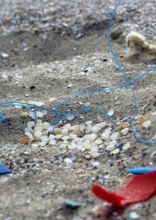
The study shows substantial spatial differences in the risk of microplastics in the ocean surface layer. The Mediterranean Sea and the Yellow Sea (near China) in particular have the dubious honour of harbouring the highest concentrations of microplastics in the surface layer of the ocean (up to a depth of five meter). The highest microplastic concentrations were estimated to be over 40 microplastics per liter of seawater in the Eastern part of the Mediterranean Sea and over 50 microplastics per liter of seawater in the Yellow Sea.
These values are lower than the predicted median concentration of 121 micoplastics per liter of seawater above which adverse ecological effects are likely to occur. However, this unacceptable level varies between a maximum of 1,500 microplastics per liter (best case scenario) and a minimum of eight microplastics per liter (worst case scenario). Hence, this study shows that certain organism in parts of the Mediterranean Sea and the Yellow Sea are currently (anno 2010) already at risk. 16% and 5% of the surface areas of the Mediterranean Sea and the Yellow Sea respectively were exposed to microplastic concentrations exceeding the most strict unacceptable level of eight microplastics per liter of seawater.
If the plastic production continues to increase at the current rate, scientists expect the global plastic production to quadruple to 1,800 megatons by 2100. With the increasing plastic production, the chance that the unacceptable concentration of microplastics will be exceeded increases. The researchers predict that under a worst case scenario, 69% of the surface area of the Mediterranean Sea and 54% of surface area of the Yellow Sea will exhibit unfavourable conditions for marine life due to micoplastic pollution by 2100.
This study shows that the risk at the global ocean surface related to the pollution by microplastics is going in the wrong direction. The increasing microplastic concentrations, which already exceed the safe standards locally, will lead to a higher chance of altered ecosystems. Additional studies investigating the interaction between microplastic exposure and other global change stressors in marine ecosystems are urgently needed. In this way, policymakers can determine priorities and implement targeted measures to tackle realistic environmental risks.

Figure: the global risks of microplastic based on worst case scenario (= eight microplastics per liter of seawater) anno 2010 (upper map) and 2100 (lower map).
Everaert G., De Rijcke M., Lonneville B., Janssen C. R., Backhaus T., Mees J., van Sebille E., Koelmans A. A., Catarino A. I. & Vandegehuchte M. (2020). ‘Risks of floating microplastic in the global ocean’ – Environmental Pollution
DOI: 10.1016/j.envpol.2020.115499 | Download pdf via VLIZ-BIB
Interactive Mapping Application for marine microplastics: http://rshiny.lifewatch.be/ng-ocean-plastic-challenge/
Press contacts